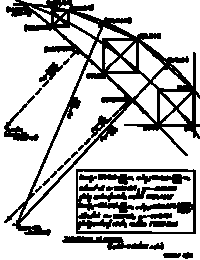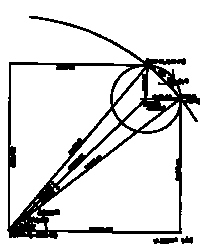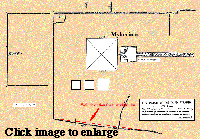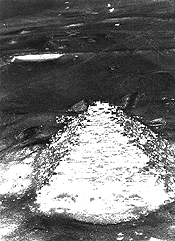
Dear Stephen, Thank you for your letter: I have now drawn up a couple of plans showing the intersections of the ground circles passing through the corners of the Giza Pyramids, and have checked all my earlier calculations to make sure that the numbers are correct. I hope you find the enclosed copies interesting! The centre of each circle (see diagram) is found from the intersections of the perpendicular bisectors of the chords joining the corners of the Pyramids; and the
It turns out that there are some quite interesting relationships as regards the intersection that defines your "vanishing point" more than I would have expected by chance - so I shall now give you a few examples. Firstly, I was surprised to find that the two circles intersect exactly 11000 cubits northwards from the centre of the large circle (I mean within about 3 inches!); and this dimension is just 25 times the base-side of the Great Pyramid of 440 cubits, and ten times the initial dimension of 1100 cubits from the north side of the Great Pyramid to the south side of the Second Pyramid. The centre of the large circle is also 13060 cubits south from the north side of the Great Pyramid, and 12620 cubits southwards from the south side of the Great Pyramid; the former being exactly 20 times the east-west distance of 653 cubits between the east sides of the Second and Great Pyramids, while the latter is just 20 times the north-south distance of 631 cubits between the south sides of the Second and Third Pyramids. As regards the smaller circle, its radius is 2742 cubits and its centre is 2740.27 cubits east from the vanishing point, these dimensions being about ten times the height of the Second Pyramid of 274 cubits. One of my main interests over the years has been to determine the position of the Sphinx, as being reputedly the point of entrance to a system of passages beneath the Pyramids. I now find, however, that your vanishing point is exactly 1000 cubits southwards from the theoretical axial line that passes through the Sphinx! These simple relationships with dimensions I worked out years ago for quite different reasons, are beginning to persuade me that there might be something in this vanishing point idea, after all. I haven't yet attempted to calculate the apex circle, since I am fairly certain that it must lie well outside the intersection of the ground circles. At any rate, this is the case when the circles are drawn in a horizontal plane (see enclosed plan);
You will find enclosed a copy of a plan by Flinders Petrie, on which I have marked the exact position of the vanishing point, 70 cubits west, and 328.5 cubits south from the south-west corner of the Third Pyramid - a position that happens to be extremely close to the southern boundary wall of the Third Pyramid. There are a few strange things about this wall, the first being that while all the other boundary walls at Giza are aligned north-south or east-west, this wall diverges by about 7 degrees from an eastwest alignment - in such as way as to just
Another very curious feature is the section of wall which leads off at about right-angles to the curved wall. The two parts of this wall look very similar in alignment to the two chords of the smaller ground circle in my construction, and might even be taken to represent a kind of small-scale model of the method required to obtain the centre of a circle. Since the builders at Giza were generally preoccupied with the construction of exact straight lines from north to south and from east to west, there must have some good reason why they decided to throw in this odd branching section of a wall, which seems to have no practical purpose.
Anyway, next time I'm in Egypt I will take a close look at this area, and perhaps make some inquiries about the direction of further clearance work.
|



